In Intensive beef production in Europe, finishing beef cattle are typically reared in pens with fully slatted (concrete) floors. Concrete flooring is a contributing factor in the development of lameness. Lameness in cattle has major economic and animal welfare implications. The impact of lameness on animal welfare is usually long lasting and associated with substantial pain, resulting in premature culling and adversely affecting performance. Softer flooring like rubber mats may help to avoid lameness in fattening bulls. In Lower Saxony (Germany) rubber mats are required in newbuild husbandry systems for fattening bulls without straw in terms of animal welfare.
Rubber mats on concrete slats can prevent slipping and falling of the animals and thus prevent injuries. Furthermore, it is easier for the animals getting up and laying down with an anti-slip floor. Rubbermats also have a beneficial impact on the carpal joints and thus on animal health and welfare despite reports about overgrown claws.
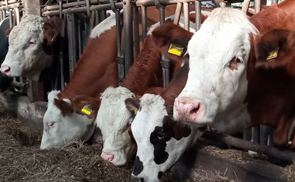
The effects of rubber mats are controversial in terms of the performance and cleanliness of the animals. There are reports about increased weight gains on rubber coated slats. However, in some studies increased weight gains could only be observed in lighter breeds or in the first part of the fattening phase.
Unicarve (Italy) has conducted a DEMONSTATION on this theme. To see this video - click here
Literature:
Huesmann A. (2019): Bullenmast auf Gummi - Fluch oder Segen? (Top Agrar)
Lowe D.E. et al. (2019): The effect of diet and covering fully slatted concrete floors with rubber strips on the intake, performance and cleanliness of dairy-origin bulls
Magrin L. et al. (2019): Health, behaviour and growth performance of Charolais and Limousin bulls fattened on different types of flooring
Murphy V.S. et al. (2018): The impact of floor type on lameness and hoof health of dairy origin bulls
Keane M.P. et al. (2018): Effect of floor type on performance, lying time and dirt scores of finishing beef cattle: A meta-analysis
Zerbe F. et al. (2008): Mastbullenhaltung - Alternativen in der Spaltbodenhaltung
Additional information

You can find further information related to the costs and benefits of this innovation by clicking on the link below:
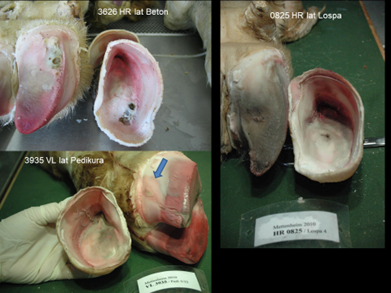
Various claw defects with infectious lesions of the corium in finisher bulls kept on concrete floors and mats: The hoof horn is harder and more robust in a dry environment, while the horn becomes softer and more prone to lesions on wet ground.
Lameness and its appearances are often difficult to assess from the outside without a detailed claw examination. From the point of view of the inner shoe of a claw, the damage can be more severe than suspected (Figures: Pododermatitis septica, Fissura ungulae [arrow] and Rusterholz pododermatitis).
(foto: FLI Germany)
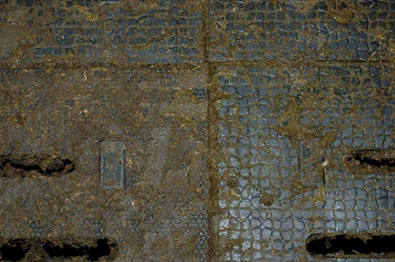
This figure shows the use of two different top-on floor qualities (right LOSPA, left PEDIKURA) for bulls on fully slatted concrete. The left rubber version is a product from dairy industry. The surface of the mats contains corundum stones to increase the abrasion of the claws. Using these mats up to 20% of the pen area is recommended, with the feeding area being preferred.
(foto: FLI Germany)
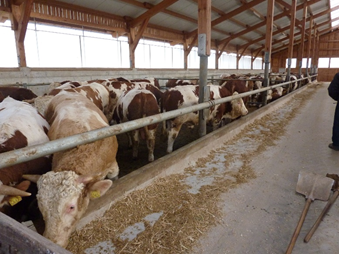
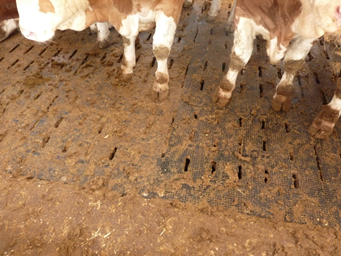 Beef farm (Bavaria, Germany)
Beef farm (Bavaria, Germany)
pens for fattening bulls with the same both types of mats. Different soiling of the rubber is due to different surface structures of the mats. Concrete floor in front to the feeding table is often used in combination with rubber mats.
This innovation has an impact on:
- Socio-economic resilience: The use of rubber mats has economic effects because of the costs for rubber mats. The results for the carcasses are controverse.
- Animal health and welfare: The prevention of lameness due to decreased slipping and falling and softer floors has implications for the health and welfare of animals.
- Production efficiency and meat quality: Higher weight gain leads to shorter fattening period however it is discussed controversial.
- Environmental sustainability: Higher weight gain leads to a better product efficiency and to shorter fattening periods, which can positively affect environmental sustainability.
Keywords: rubbermats; flooring; lameness; claw health; fattening bulls; animal welfare